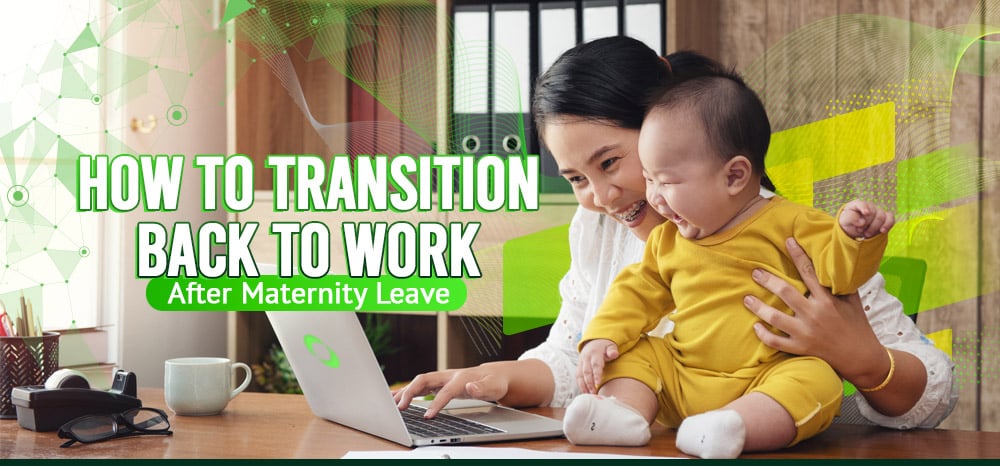Introduction
Going back to work after maternity leave can be tough.
Separation anxiety, sleepless nights, and balancing work with childcare can be overwhelming.
On top of that, new parents may worry about job performance, workplace changes, and finding reliable childcare.
So adjusting to a new routine is not just about returning to work—it’s about finding a balance that supports both career and family while ensuring a smooth transition for everyone involved.
Here are some simple ways to ease the transition:
Preparing for Your Return
Planning ahead can make the transition easier. Here are a few steps to help you get ready for your return to work:
Communicating with Your Employer
Being transparent about the support you need is imperative.
If possible, discuss your workload, flexible hours, remote work, or other support you may need.
You might also consider requesting a phased return or extra breaks for breastfeeding at work (if you work from home) or pumping.
Being clear about your expectations and concerns can help create a smoother experience for both you and your employer.
Planning Childcare Arrangements
Arranging childcare in advance can help reduce stress when returning to work.
Explore childcare options like daycare, a nanny, or family support, and choose what works best for your schedule and budget.
In case of emergencies, have a backup plan, such as a trusted relative, babysitter, or emergency daycare to avoid last-minute stress.
Managing Work-Life Balance
Juggling work and family after maternity leave can be challenging, but setting boundaries and managing your time well can help workplace reintegration and work-life balance.
Setting Realistic Expectations
Adjusting to work and family life takes time, so working moms should set realistic expectations and focus on progress, not perfection.
- Prioritize tasks – Focus on what truly needs to be done each day.
- Be patient with yourself – Post-maternity transition takes time, and it’s okay not to have everything figured out right away.
- Accept flexibility – Some days will be smoother than others and vice versa; roll with the punches as needed.
- Celebrate small wins – Acknowledge your progress, no matter how small.
By setting realistic expectations, working moms can create a balance that works for them over time.
Leveraging Flexible Work Arrangements
Flexible work arrangements can help working moms balance career and family responsibilities more effectively.
Here are some options you can discuss with your employer:
- Remote work – If possible, work from home to save on commuting time.
- Flexible hours – Adjust your start and end times to better fit your family’s schedule.
- Compressed workweeks – Work longer hours on fewer days to have extra time off.
- Part-time or job sharing – Consider reduced hours or splitting responsibilities with a colleague.
- Hybrid setup – Combine office and remote work for a balanced routine.
- KIT (Keep In Touch) days – Use optional workdays to stay updated, attend meetings, or reconnect with colleagues without officially returning to work.
By negotiating these flexible work options, you can create a work schedule that supports both your professional goals and family responsibilities.
Overcoming Emotional Challenges
Returning to work after maternity leave can be an emotional experience, bringing feelings of guilt, anxiety, or even excitement.
Emotional adjustment takes time, but there are ways to make the transition smoother:
Coping with Separation Anxiety
Being away from your baby after parental leave can be difficult, but there are ways to ease the turnover timeline:
- Create a goodbye routine – A quick hug, kiss, or special phrase can help reassure your baby and yourself.
- Stay connected – Check in with your caregiver for updates or look at photos and videos during breaks.
- Trust your childcare choice – Knowing your baby is in good hands brings peace of mind. To do this, research options, check reviews and do trial runs with caregivers.
- Be kind to yourself – Feeling emotional is normal; give yourself time to adjust.
With time and consistency, both you and your baby will adapt to the new routine, helping to ease post-maternity work stress.
Building a Support System
Having a strong support system can make the transition back to work easier and less stressful.
Here are some ways to build support:
- Lean on family and friends – Don’t hesitate to ask for help when needed.
- Connect with other working moms – Join parenting groups or online communities for advice and encouragement.
- Talk to your employer – Discuss any flexible work options or resources available.
- Consider professional support – A counselor or coach can help you navigate the emotional challenges.
Surrounding yourself with supportive people can make balancing work and family life much more manageable.
Boosting Your Career Post-Maternity Leave
Returning to work after maternity leave is a chance to refocus on your career goals, enhance your skills, and explore new growth opportunities.
Rebuilding Confidence at Work
Resuming your career after maternity leave can be challenging, but confidence grows with time and small steps.
Here’s how to regain confidence:
- Recognize your strengths – Remind yourself of the skills and experience you bring.
- Stay informed – Catch up on industry trends, company updates, and new tools.
- Set achievable goals – Focus on small wins to rebuild momentum.
- Seek support – Connect with colleagues, mentors, or fellow working moms for guidance.
- Be patient – Adjusting takes time, so give yourself grace as you settle back in.
With consistency and support, an employee’s transition back to work becomes easier, helping them regain confidence and thrive in their role.
Exploring Career Flexibility
After maternity leave, some parents reassess their career goals and seek more flexibility to juggle work and family life.
Having a flexible career can reduce stress, improve productivity, and create a better work-life balance.
Some choose to negotiate for home-based employment, while others look for online career openings, explore work-from-home opportunities, or consider freelancing to gain more control over their schedules.
By considering different options, you can create a fulfilling career while effectively managing both work and family responsibilities.
Practical Tips for a Smooth Transition
Returning to work can be smoother with the right planning and support. Here are some practical tips:
Establishing a structured daily routine.
Creating a consistent daily routine can help balance work, childcare, and personal time more effectively.
To stay organized and reduce stress:
- Set a morning routine – Prepare for the day by organizing meals, clothes, and essentials the night before.
- Plan work hours – Stick to a schedule that aligns with your job and family needs.
- Schedule breaks – Take short breaks to recharge and manage stress.
- Wind down in the evenings – Establish a bedtime routine for yourself and your baby to ensure rest and relaxation.
Meal prepping and organizing household tasks in advance.
Planning meals and household chores ahead of time can save energy and reduce daily stress.
To make daily routines easier:
- Meal prep in batches – Cook and store meals for the week to save time on busy days.
- Create a chore schedule – Assign tasks to family members or set specific days for cleaning and errands.
- Use time-saving tools – Try grocery delivery, slow cookers, or meal-planning apps. You can also check these apps for some recipes, shopping lists, and meal prep ideas.
- Prepare essentials the night before – Lay out clothes, pack bags, and organize work or school items.
Taking short breaks to recharge and avoid burnout.
Stepping away from work, even briefly, can improve focus, reduce stress, and boost overall well-being.
Ways to recharge during the day:
- Take mini-breaks – Stretch, walk, or practice deep breathing for a quick reset.
- Step outside – Fresh air and a change of scenery can improve mood and energy.
- Unplug for a moment – Pause from screens to rest your eyes and clear your mind.
- Enjoy a small treat – Have a coffee, listen to music, or do something relaxing.
FAQ
Have some questions? Here are answers to common concerns about returning to work after maternity leave.
How do I deal with mom guilt when returning to work?
Mom guilt can be tough, but remind yourself that it’s normal to feel this way and that you’re doing your best for your family.
You can also try shifting your perspective.
Focus on quality time with your child and the love you provide, not just the time apart.
You can also check these helpful tips and insights on managing mom guilt.
How do I cope with postpartum depression while returning to work?
Postpartum depression can happen after childbirth due to hormonal changes, lack of sleep, and the stress of adjusting to motherhood, making returning to work even harder.
To cope, seek professional help, talk to loved ones, and discuss any needed adjustments with your employer.
Prioritize self-care, take breaks, and consider joining a support group.
How do I rebuild my confidence at work after maternity leave?
It’s normal to feel uncertain after time away, but confidence grows with time and small steps.
Refresh your skills, stay updated on workplace changes, and set achievable goals.
Seek support from colleagues, mentors, or other working moms, and celebrate small wins along the way.
Conclusion
Transitioning back to work after maternity leave takes time, patience, and the right strategies.
Be kind to yourself, knowing that balancing work and motherhood is possible with realistic expectations and a strong support system.
Prioritizing self-care, seeking help when needed, and embracing flexibility like having an online job can make the process smoother.
So if you’re looking for remote opportunities, Remote Staff is actively hiring work-from-home professionals, allowing you to grow your career while spending more time with your family.
Register today to discover flexible job opportunities that support your career and newfound motherhood!








